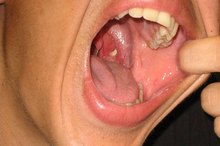How to Cure Cryptic Tonsils
Tonsils are two masses of prominent lymphoid tissues that are situated on each side of the throat. These pair of tissues act as part of the body's immune system, filtering harmful microorganisms including viruses and bacteria as they enter the nose or the mouth. When the tonsils get inflamed, it will result to a condition called tonsillitis. And recurring tonsillitis can lead to chronic cryptic tonsillitis-- a case where sick tonsils contain many small hidden pockets (crypts) to where food particles and other debris are trapped. These particles contain bacteria and dead cells that will eventually form an unpleasantly odorous white particles called tonsilliths or tonsil stones. Many cases of chronic cryptic tonsillitis are often mild and do not require surgery.
Take some antibiotics. This can be beneficial in providing temporary relief and also helps to get rid of bacteria present within the crypts. In some cases where tonsils are severely inflamed and make swallowing difficult, patient may be required to stay at the hospital for administration of intravenous fluid.
Plaque Build-Up in Throat: Is it Possible?
Learn More
Boil a cup of vinegar. Settle it for a bit until it's tolerably warm enough and then gargle the solution. This will help clear off the hidden pockets (crypts), provides transient pain relief and prevents formation of tonsil stones.
Get the tonsilliths out without scratching your tonsils. This can be done by using a cotton swab to carefully pick the tonsil stones out of the pits or crypts. Performing this method is quite difficult since it can trigger the gag reflex that can make you cough or feel like vomiting. If you are not sure how to do this, visit your doctor to safely remove your tonsil stones.
What Are the Dangers of Leaving Tonsillitis Untreated?
Learn More
Ask your doctor if laser treatment or surgical procedure is applicable for your case. Laser treatment helps in making the surfaces of the tonsils smooth thereby getting rid of the hidden pockets or crypts. Surgical procedure called tonsillectomy (removal of tonsils) may also be an option for worse cases of cryptic tonsillitis.
Tips
Contact your doctor immediately if your cryptic tonsillitis is associated with high fever, intense pain in the throat area, swallowing difficulties, severe sore throat and breathing difficulties.
Related Articles
References
- Bai, K.Y. & Kumar, B.V. (2015). Tonsillolith: A polymicrobial biofilm. Medical Journal Armed Forces India. 71(1), S95–S98. doi:10.1016/j.mjafi.2011.12.009
- Ferguson M, Aydin M, Mickel J. Halitosis and the tonsils: a review of management. Otolaryngol Head Neck Surg. 2014;151(4):567-74. doi:10.1177/0194599814544881
- Bollen CM, Beikler T. Halitosis: the multidisciplinary approach. Int J Oral Sci. 2012;4(2):55-63. doi:10.1038/ijos.2012.39
- Krespi, Y.P. & Kizhner, V. Laser tonsil cryptolysis: In-office 500 cases review. American Journal of Otolaryngology. 2013; 34(5), 420–424. doi:10.1016/j.amjoto.2013.03.006
- Siber S, Hat J, Brakus I, et al. Tonsillolithiasis and orofacial pain. Gerodontology. 2012;29(2):e1157-60. doi:10.1111/j.1741-2358.2011.00456.x
- Wetmore, RF. Tonsils and Adenoids. In: Kliegman RM, Stanton BF, St Geme JW, Schor NF, Behrman RE, editors. Nelson Textbook of Pediatrics. 20. New York: Elsevier; 2015. pp. 2023-2026.
Tips
- Contact your doctor immediately if your cryptic tonsillitis is associated with high fever, intense pain in the throat area, swallowing difficulties, severe sore throat and breathing difficulties.
Writer Bio
Wirnani Garner holds a Bachelor of Science degree in physical therapy and works in the medical profession. Her articles focus on health-related subjects, though Garner is proficient in researching and writing about a diverse range of topics.









